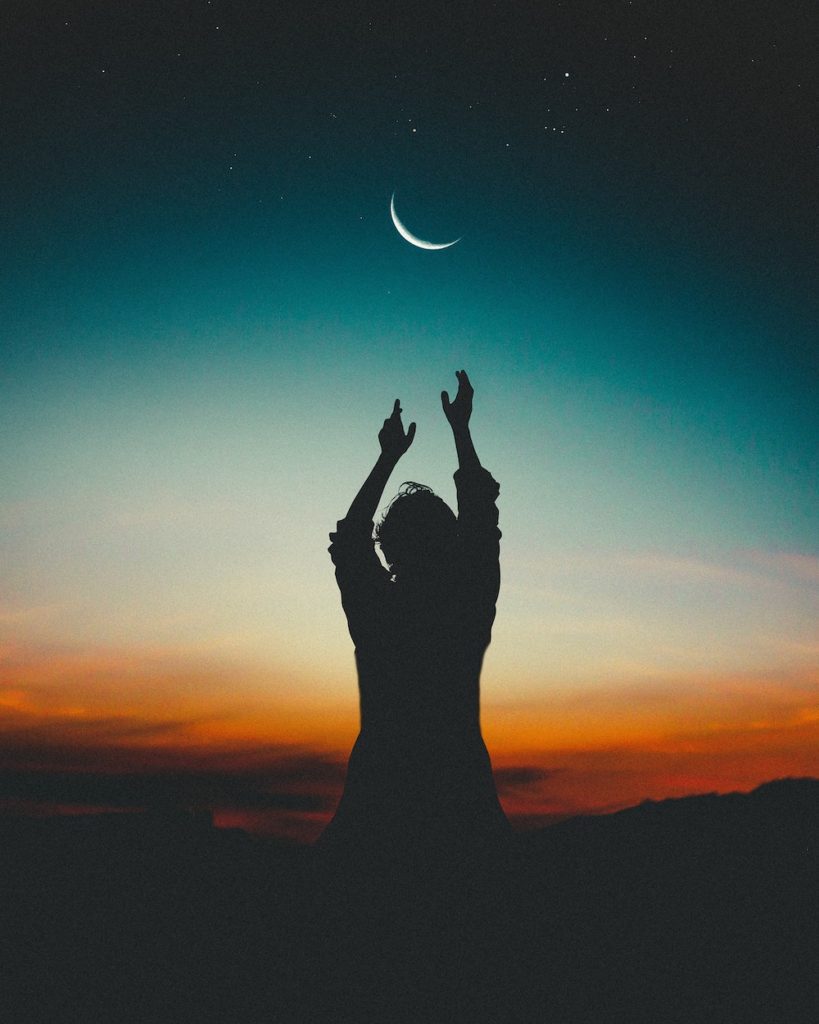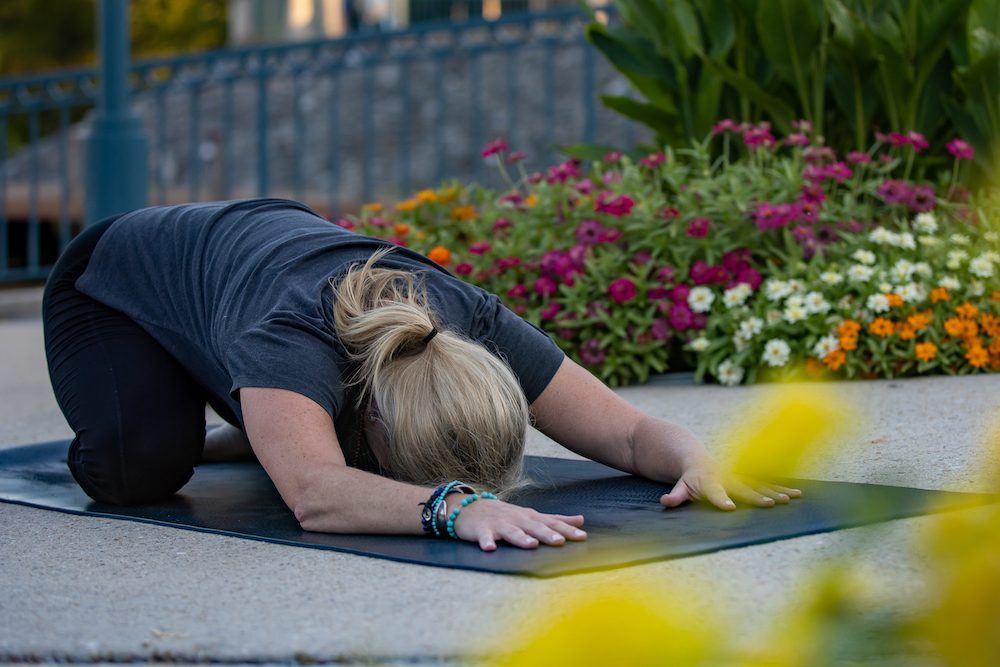“Enlightenment is ego’s ultimate disappointment.”
~ Chogyam Trungpa

Years ago, in a Max Strom Workshop, he instructed the group:
Level one, please take Child’s Pose. Level two, Downward Dog. Level three, take Plank.
I felt my body move into plank, but immediately questioned if it was where I should be?
My focus switched from my breath to my internal dialogue that went something like this:
Level three? Am I level three? What is level three? Plank does feel good right now. Maybe he is watching to see who thinks they are a “level three,” whatever that is? Great, I bet he is going to start talking about how we should all have beginner minds. Are the people around me doing plank? C’mon Michele, seriously? Just breathe.
It constantly amazes me how every part of my personality is exposed when I am on my yoga mat. Whatever is “up” for me is revealed as I move through poses and sit in stillness. Over the years, every mind-created obstacle that exists (ego, sadness, anger, resentment, jealousy, etc.) has surfaced at some point during my practice.
With that said, for me, ego is one of the trickiest obstacles to rise to the surface. Ego leaves me in a self-focused space and my connection to the things that matter are seemingly lost.
I love the acronyms: Edging Good Out or Edging God Out.

You can be certain that if I am coming from an ego place, I am not thinking of the greater good. In fact, what is happening, is that my “yoga” (my “joining”) is being interrupted by my mind—by my thinking. There is a thought that somehow I am separate, or different from that goodness with which I aim to connect.
In yogic philosophy, the ego is sometimes called Asmita, or false-identification. It arises when our true self somehow identifies and defines itself as an aspect of the mind or body. In our modern world, this can be a common occurrence. The way we look, what we drive, our partner, where we live—and yes, even the way we practice yoga the way we practice yoga can at times become part of our identity.
When I think I am something other than the pure light that is all things, I am setting myself up to suffer. The only thing that does not change is the true self (the pure light that is all things). The mind-created obstacles often surface when we have fallen into the trap of thinking that somehow we are the changeable byproducts of our true self. And simply because these things never stay the same, if I have defined myself as a changeable thing and it shifts, I lose my sense of self.
Ego comes between me and goodness and, like a slamming door, cuts off any chance for connection to happen.
I’ve heard some yoga teachers say, “Leave your ego outside the yoga room.” It seems counterintuitive that ego would be something that comes up in a yoga class. But, it does. And, it pops up in all sorts of ways.
One of the most common is thinking that doing a certain pose or yoga style makes me strong, advanced, a real yogi, intelligent or fill-in-the-blank with any label or judgment! The moment I label or judge my practice, ego has taken the reins.
That judging can simply be dangerous, never mind joyless. When we stop listening to our body, injury often results. Notice arms shaking with fatigue, and bodies drenched in sweat. Still, the ego-fueled practice pushes us into one more pose, ignoring what the body tells us. It doesn’t look like yoga. It looks uncomfortable. Painful. Dangerous.
There is a world of difference between challenging physical and mental states, and doing a pose because we think we should or have to.
While doing my teacher training, I had the privilege of observing many different classes and levels at a popular studio in Los Angeles. I was shocked by how many students in the “easier” classes had more advanced practices than those taking the “hard” classes. I watched people in “advanced” classes kicking into headstand with their shoulders sagging, taking warrior two with their knee rolling in, and jumping back and forth with stiff joints and loud thuds.
There seemed to be an innate competition happening in some of the so-called advanced classes. People were looking around a lot, breathing as if they were being chased, and getting injured way too often. I was very confused by the tangible, almost selfish energy I sometimes felt in the room.
Even though I was coming from the world of dance and found great enjoyment in a physically vigorous practice, I was turned off by what was going on in those classes and found myself drawn to a very deep and therapeutic practice instead: classes where we stayed on our backs for 90 minutes, immersed in the breath, never once looking around the room. Clearly, my ego needed this kind of taming and quieting.

When ego clouds the window through which I view life, sometimes it will try to make me feel really good about myself. And, also really bad about myself.
Have you ever looked around the room in a yoga class (or skimmed through social media) and watched someone do some awesome pose? Then, all of a sudden, you felt like crap because somehow ego crept into the picture and made you part of the equation?
Or those times when ego goes so far that you find things “wrong” with your physical body?
Compare and despair. The moment “I” takes focus within a negative form, there is no getting out alive.
This can be especially hard for some people who are new to yoga. I have heard countless new students criticizing themselves. Just yesterday, a new student came up to me before class and said, “I am really bad at yoga.” What!!?? In so many parts of life we are conditioned to compare, judge,and compete.
Letting that go takes some work. To a certain extent, this is part of the process for most people. Part of the practice. These mind-obstacles arise to give us the opportunity to work through things.
I consider this a gift. Yoga gives me the space to safely explore what arises. What is really going on with me on those days that I want to be my worst critic? Underlying the ego (and most all of the feelings and mind projections) is a giant pool of fear. It is easier to judge, be angry, and beat myself up than to sit with discomfort or the unknown. Sometimes is seems easier to focus on someone else (or the false parts of myself!) than on my true self.
So, how do we use the practice of yoga to tame the part of the ego that causes harm?
How do we create a practice that connects to the true Self—our Higher Self?
These are questions that the actual process and study of yoga will answer.

“Being must be felt. It can’t be thought.”
~ Eckhart Tolle
1. Stop thinking.
Seriously. I know, it’s easier said than done and this might even sound a little crazy to some. But, when we listen to the body instead of the mind, we will tap into deep wisdom. Bypass the thinking by:
- Making the breath the most important thing.
- Feeling the way the body moves through breathing. Hear it. Dive into the ocean sound of it. Try not to move unless the breath is there first, leading the way.
- Noticing the sensations in the body and exploring those sensations to be in the moment.
- Creating an inner or outer focal point to focus on.
2. Explore all of yoga.
The asana is only one limb of yoga—it’s just the tip of the iceberg! Under the surface is a universe to expand upon, with seven more complete limbs that go deeper than is imaginable. Those limbs give us freedom, peace, strength, guidance and enlightenment. Those limbs offer tools to weave into the physical practice to quiet the mind.
3. Remember why we do this.
At the beginning of each practice, I silently set an intention for my practice—an intention for presence. Why am I doing yoga? I return to my intention again and again throughout my practice.
4. Close the eyes in order to see.
If I sense my ego trying to pop up, I surrender into child’s pose. Or, I go to a beginner class and get back to the basics so that I can really hear my body’s intelligence. I choose to go inside instead of out. When I withdraw the senses, there is room to explore the internal landscape.
5. Align yoga with life.
Every once in a while I check in with myself, or my teachers, and ask if my yoga practice as a whole is supporting a life that my heart desires. I make adjustments accordingly.
6. Don’t take ourselves too seriously.
I take the yoga seriously, but not myself. I check in to see if there is a sense of ease and steadiness in my practice. If I fall, I laugh quietly or internally. I invite lightheartedness into my practice. I choose classes and teachers that embrace that openness.
7. Make practice an offering.
How can I be of service? Sometimes that is as simple as smiling at the person next to me or silently dedicating my practice to someone in need. I ask: how can I use my practice to help others shine?
I wish I wrote this from a place where I could say, “I am free of ego.” But I’m not. I use yoga to help me find freedom. I use “yoga” to practice yoga in a healthy way. It starts on my mat and then transfers into my life.
In Max’s workshop it took me a few moments, but I was able to reconnect with my breath. I pulled my focus inside, and stopped being concerned about what others were doing and what I “should” be doing. I embraced what was happening in the moment, in my body, and absorbed the instruction from a great teacher.
Needless to say, there was no lecture on our “level,” just a reminder from Theodore Roosevelt, channeled by Max, to:
“Do what you can, with what you have, where you are.”
Yoga photos by The Five Arrows Media

